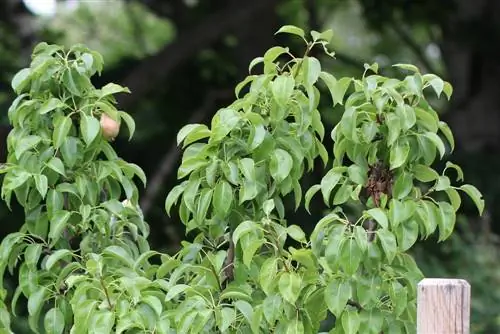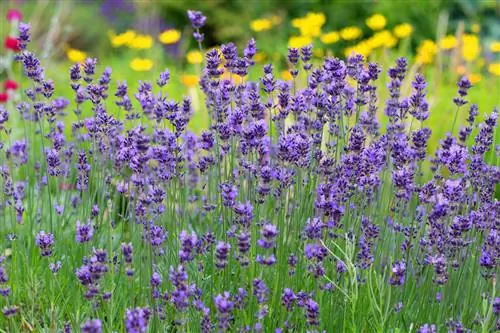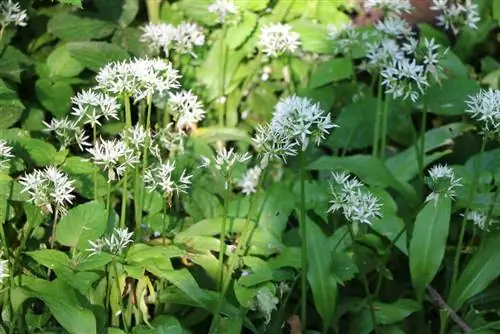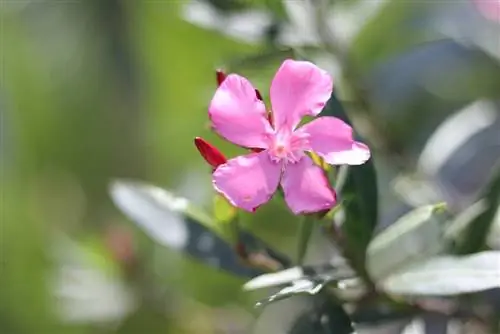- Author admin [email protected].
- Public 2023-12-17 03:39.
- Last modified 2025-01-24 12:45.
Fire blight is a dangerous disease caused by the bacterium Erwinia amylovora. The disease primarily affects fruit trees, where this pathogen can even overwinter. As a rule, there is a significant loss of yield as the disease progresses, and untreated plants often die completely within a few years. These bacteria do not affect people and pose no he alth risk. When the first identifying characteristics appear and an infestation occurs, there is a legal obligation to report it.
Distinguishing features
If the plant is infected with fire blight, the bacteria are transported into the water channels of the fruit trees. Over time, these pathways become clogged with excreta, as water transport in the host plant is restricted. An infestation can be recognized by very specific symptoms, which make the plant look like it has been burnt. That's why the bacterial disease is called fire blight. Plants that are still young die off relatively quickly; due to the immune system not being fully developed, this occurs after just two to three weeks. Older plants fight the pathogen, so it can take years for the disease to spread completely and ultimately lead to death. The severity of the infestation depends on many criteria, including the climate and conditions at the location. But the plant variety, the respective state of he alth and the density of the bacteria also play a decisive role.
- Leaves and flowers begin to wilt, starting from the petiole
- These then turn brown or black
- Affected plant parts remain attached to the host
- Shoot tips curve downwards in the shape of a hook
- Bacterial mucus emerges from the infected areas
- Mucus formation occurs in summer and autumn
- In winter the bark sinks in
Tip:
If you are unsure about the identifying features, you should get certainty with a laboratory test. This means that other diseases with similar symptoms can be completely ruled out.
Dissemination
The bacterial pathogen can spread and attack fruit plants in many ways. Either the disease became active in the host before planting and was then introduced into the new garden. Or the plants were only infected with fire blight much later, when they had already settled in their new location.
- Planting already infested plants
- Transportation in contaminated packaging material
- Contaminated cutting tools
- Spread through extreme weather conditions, such as strong wind and rain
- Spread by insects, humans, animals and migratory birds
Fight
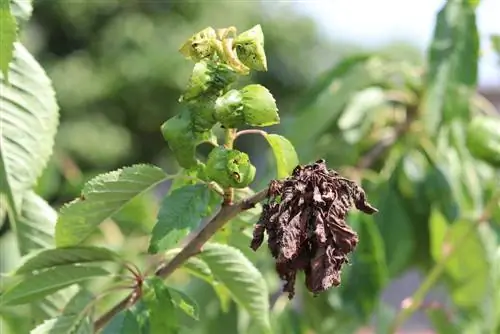
During the flowering period, susceptible plants should be checked regularly for symptoms of fire blight. If an infestation is detected, immediate action is required. After the control measures, the affected plant must be checked again for the pathogen several weeks later. A new infestation often occurs; if this occurs, the only solution is to immediately remove the entire host plant. A subsequent inspection of the plants in the area should be carried out mandatory next year.
- Cut affected shoots back deep into the he althy wood
- Completely clear trees that are already heavily infested
- Disinfect used scissors and tools before and after contact
- Alcohol is perfect for this, with a content of at least 70%
- Sterilize the cutting tool in alcohol for at least 10-15 minutes
- Burn diseased plant material on site as quickly as possible
- Dispose of burned waste in household waste
- Under no circumstances throw it in the compost bin
- Do not dispose of in the organic waste bin either
Tip:
If whole and larger trees have to be completely cleared, then they must be taken to waste incineration due to the volume involved. This should also be done if burning on your own property is not possible.
Treatment
The use of antibiotics and bactericides is strictly prohibited in organic fruit cultivation and for use in home and allotment gardens. As an alternative, there are natural methods that have proven effective in many cases of illness. The antibiotic streptomycin is used in professional fruit cultivation. However, this can pose a he alth risk to the user and permanently weakens the immune system of the host plant. In addition, residues of streptomycin can be detected in honey, meaning that it is contaminated and must be disposed of. In addition, resistance quickly develops on the part of the bacterial pathogen.
- Prefer natural antidotes
- Yeast preparations have an efficiency of almost 70%
- Yeast-like fungus colonizes the flower base
- This prevents the pathogen from penetrating
- Apply the agent preventively before the pathogen can attack the host plant
- Particularly effective on young trees with a small crown
Prevention
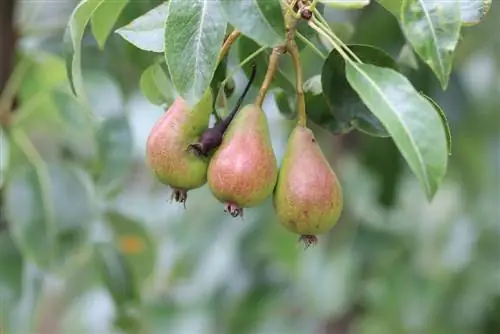
Unfortunately, it is not possible to completely protect the plants in your own garden from fire blight. However, selecting fire blight-resistant varieties for new plantings is a big help. Soft fruits, stone fruits, conifers and most deciduous trees are completely resistant to fire blight. Susceptible varieties that have already been planted must be checked regularly for infestation, especially immediately after flowering. The dangerous time for infection extends until early summer, as the bacterium finds perfect growth conditions at warm and humid temperatures of 21-28° C. The sooner the fire blight is discovered, the sooner action can be taken to prevent it from spreading further. In addition, it is extremely important to disinfect all cutting tools used with high-percentage alcohol before and after use.
Low susceptible apple varieties
- Danziger Kantapfel
- Florina
- Bell apple
- Meow Apple
- Remo
- Rewena
- Beautiful from Boskoop
- Beautiful from Wiltshire
- Swiss orange apple
Low susceptible pear varieties
- Bavarian wine pear
- Champagne Roasted Pear
- Harrow delight
- Harrow Sweet
- Welsh roast pear
Reporting requirement
As soon as a plant has been infected with fire blight, the occurrence of the disease in Germany must be reported immediately. Due to the dire effects and the epidemic-like spread, even the mere suspicion is subject to reporting requirements. The ordinance for combating fire blight disease serves as the legal basis; this fire blight ordinance is always valid in the updated version.
- Reporting requirement varies depending on the federal state
- Report either to the state office or the state office for agriculture
- Responsible authority orders a quarantine zone in the event of a severe infestation
- This zone is around five kilometers around the infested properties
Host plants
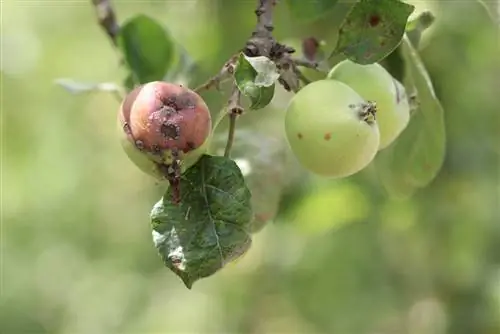
The host plants primarily include the species and genera from the rose family, mainly the pome fruit family. The bacterium can only overwinter on these types of plants and infect the host for years. Domestic apple trees, which are very popular in these latitudes, are particularly often affected. In addition to fruit trees, ornamental and wild trees are also extremely susceptible to the bacterial disease. When planting new plants, attention should therefore be paid to robust and less susceptible varieties, especially if an infestation with the bacterium has already occurred in the area.
Frequently affected apple varieties
- Cox Orange
- Granny Smith
- Elstar
- Gala
- Gloster
- Jonathan
- Jonagold
- Mostäpfel
Susceptible pear varieties
- Comic
- Conference
- Concorde
- Good Luise
- Pastor pear
- Most pears
Susceptible ornamental plants from the rose family
- Cotoneaster
- Rowberry
- Hawthorn
- Ornamental quince
Susceptible ornamental trees
- Serviceberry
- Medlar
- Quinces
- Speierling
Susceptible wild trees
- Chokeberry
- Rock Pear
- Firethorn
- Whiteberries
- Hawthorn
- Rowberries
- Wild apples
Conclusion
Anyone who cultivates fruit trees in their garden should be aware of possible diseases. One of the worst diseases is the bacterium Erwinia amylovora, as it is extremely difficult to fight. The infestation often ends with the death of the host plant if countermeasures are not taken quickly enough. The bacterial disease spreads quickly and like an epidemic, often affecting entire orchards and orchards. If the bacterial disease is recognized quickly enough, then only vigorous pruning of the affected areas, right down to the he althy wood, will help. However, in many cases the affected trees have to be cleared and burned. In Germany there are no approved antidotes for fire blight for private users, so preventive measures are necessary. The epidemic can be avoided simply by choosing the types of fruit. If you choose resistant plants, you are on the safe side in the long term. However, hobby gardeners also have to be careful with the plants around the fruit trees. Firethorns, redthorns, hawthorns and other popular ornamental and wild trees are often attacked. This infestation can subsequently lead to infection of the fruit trees. It is crucial to regularly check all susceptible plants in the garden, especially immediately after flowering and into the summer. Only if the identifying features are identified early can anything be achieved by pruning. However, if the disease has already spread widely, then the only solution is usually clearing and burning.

